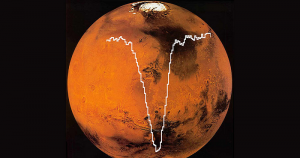
NASA’s Flying Observatory Detects Atomic Oxygen In Martian Atmosphere For The First Time In 40 years
Oxygen atoms are detected for the first time in four decades in the atmosphere of Mars. Stratospheric Observatory for Infrared Astronomy (SOFIA) made possible this discovery. SOFIA is not a stationary observatory when it is attached to the plane and takes its measurements while flying 45,000 feet above Earth surface.
In the upper atmosphere of Red Planet, the oxygen atoms are located which is known to scientists as Meosphere. Astronomers can get a better understanding through this regarding how the gases leached out from the Mars atmosphere early in planet`s history. Scientists consider Mars as a potential future home for humanity where one can possibly turn if Earth becomes uninhabitable or our population swells a level that Earth can sustain.

Scientists at the time of Martian Oxygen are keeping a question that he concentration they picked up is the result of atmospheric variations. In past about 1970`s the Mariner and Viking missions picked up Red Planets oxygen too.
“Atomic oxygen in the Martian atmosphere is notoriously difficult to measure. To observe the far-infrared wavelengths needed to detect atomic oxygen, researchers must be above the majority of Earth’s atmosphere and use highly sensitive instruments, in this case, a spectrometer. SOFIA provides both capabilities.”
Earth skies and abundantly moist and dense atmosphere stood in the way of detection of oxygen on Mars for 40 years. Water density of Earth`s atmosphere makes it incredibly challenging for scientists and researchers on Earth`s Surface to a good glimpse of anything beyond. Scientific research technology has greatly advanced in the last half century where SOFIA solved this problem and detected oxygen on Mars by rising above it.
Scientists of NASA are very happy to tell the world of their historic discovery which they have yet to release details on exactly how much oxygen they observed in Mars. The team expected to continue using SOFIA to collect data from other areas of Red Planet`s atmosphere.